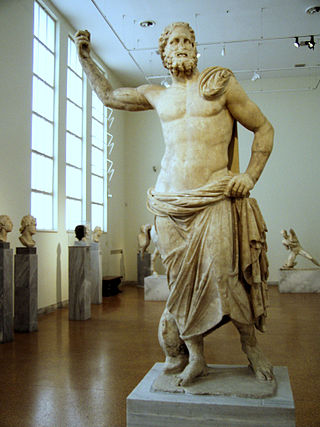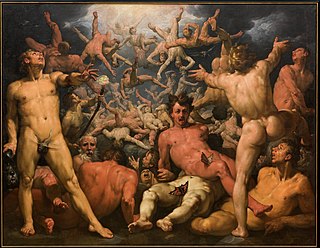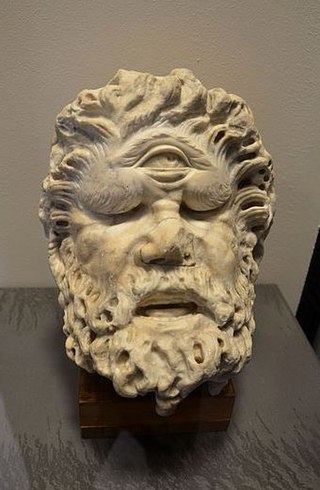
The trident of Poseidon and his Roman equivalent, Neptune, has been their traditional divine attribute in many ancient depictions. Poseidon's trident was crafted by the Cyclopes.

The trident of Poseidon and his Roman equivalent, Neptune, has been their traditional divine attribute in many ancient depictions. Poseidon's trident was crafted by the Cyclopes.

In Greek mythology, Poseidon's trident was forged by the Cyclopes according to Pseudo-Apollodorus's Bibliotheke . [1] [2] [a]
Poseidon wields his trident on a number of occasions. He used his trident to strike a rock upon the hill of the Acropolis, producing a well of seawater, in what developed into a contest between him and Athena over possession of Attica. When he lost, Poseidon used the trident to dry out the land so they had no water. The well was later to be called the Erechtheis. [3] [4] [5] There is further myth that Poseidon (Neptune) produced a horse by striking the earth with the trident, in order to bolster his claim, [6] but there is no attestation for this among Greek writers. [7] The alleged trident print on a rock and the sea well within the Erechtheion were witnessed by the geographer Pausanias while visiting Athens. [b] [8] [3] [7]
In another myth, Poseidon creates a spring or springs with the strike of his trident to reward Amymone for her encounter with him. [9] In a version of another myth Poseidon wields his trident to scare off a satyr who tries to rape Amymone after she mistakenly hits him with a hunting spear. [9]
There is also a myth where Poseidon touches the island of Delos with his trident, affixing it firmly to the sea floor. [10] Another myth tells how Poseidon, enraged by sacrilegious behavior of Ajax the Lesser, uses the trident to split the rock to which Ajax was clinging.
The oldest coins of Poseidonia from the 6th century BC depict a trident wielded by Poseidon in his right hand, similar to Zeus's thunderbolt. An Attic red figure kylix from c. 475 BC depicts Poseidon killing the Giant Polybotes with his trident. [11]
According to the second and third Vatican Mythographer, Neptune's trident symbolizes the three properties of water: liquidity, fecundity and drinkability. [12]
The trident of Neptune was viewed by Roman scholar Maurus Servius Honoratus as three-pronged because "the sea is said to be a third part of the world, or because there are three kinds of water: seas, streams and rivers". [12]
The view shared by Friedrich Wieseler, E. M. W. Tillyard and several other researchers is that Poseidon's trident is a fish spear, typical for coast-dwelling Greeks. [13]
According to Robert Graves, however, both Poseidon's trident and Zeus's thunderbolt were originally a sacred labrys, but later distinguished from each other when Poseidon became god of the sea, while Zeus claimed the right to the thunderbolt. [14]
According to a competing proposal by H. B. Walters, Poseidon's trident is derived from Zeus's lotus scepter, with Poseidon being Zeus in his marine aspect. [13]

In present times, Poseidon's trident is a recurring symbol. It appears on the coat of arms of Liverpool City Council, on the seal of the Greek Navy, and on the crest of the Delta Delta Delta sorority. It is a recurring motif in the US military, being featured on the crest of the United States Navy SEALs and on the badge of USS John S. McCain. A series of American fleet ballistic missiles Trident is named after Neptune's trident, [15] as well as Operation Neptune Spear.
The personification of Great Britain, Britannia is depicted with the trident of Poseidon as a symbol of naval power. The broken tip of the trident appears on the flag of Barbados. In this instance, the reference is to its use as Britannia's trident, broken to symbolise the end of Britain's colonial rule.
The logo of car manufacturer Maserati is based on the trident from the statue of Neptune in Bologna. [16]
The trident also appears multiple times in popular culture.

Poseidon is one of the Twelve Olympians in ancient Greek religion and mythology, presiding over the sea, storms, earthquakes and horses. He was the protector of seafarers and the guardian of many Hellenic cities and colonies. In pre-Olympian Bronze Age Greece, Poseidon was venerated as a chief deity at Pylos and Thebes, with the cult title "earth shaker"; in the myths of isolated Arcadia, he is related to Demeter and Persephone and was venerated as a horse, and as a god of the waters. Poseidon maintained both associations among most Greeks: he was regarded as the tamer or father of horses, who, with a strike of his trident, created springs. His Roman equivalent is Neptune.

Pegasus is a winged horse in Greek mythology, usually depicted as a white stallion. He was sired by Poseidon, in his role as horse-god, and foaled by the Gorgon Medusa. Pegasus was the brother of Chrysaor, both born from Medusa's blood when their mother was decapitated by Perseus. Greco-Roman poets wrote about his ascent to heaven after his birth and his obeisance to Zeus, who instructed him to bring lightning and thunder from Olympus.

Zeus is the sky and thunder god in ancient Greek religion and mythology, who rules as king of the gods on Mount Olympus.

In Greek mythology, the Titans were the pre-Olympian gods. According to the Theogony of Hesiod, they were the twelve children of the primordial parents Uranus (Sky) and Gaia (Earth), with six male Titans—Oceanus, Coeus, Crius, Hyperion, Iapetus, and Cronus—and six female Titans, called the Titanides or Titanesses—Theia, Rhea, Themis, Mnemosyne, Phoebe, and Tethys.

In Greek mythology and later Roman mythology, the Cyclopes are giant one-eyed creatures. Three groups of Cyclopes can be distinguished. In Hesiod's Theogony, the Cyclopes are the three brothers, Brontes, Steropes, and Arges, who made Zeus's weapon, the thunderbolt. In Homer's Odyssey, they are an uncivilized group of shepherds, the brethren of Polyphemus encountered by Odysseus. Cyclopes were also famous for being the builders of the Cyclopean walls of Mycenae and Tiryns.
Asopus is the name of four different rivers in Greece and one in Turkey. In Greek mythology, it was also the name of the gods of those rivers. Zeus carried off Aegina, Asopus' daughter, and Sisyphus, who had witnessed the act, told Asopus that he could reveal the identity of the person who had abducted Aegina, but in return Asopus would have to provide a perennial fountain of water at Corinth, Sisyphus' city. Accordingly, Asopus produced a fountain at Corinth, and pursued Zeus, but had to retreat for fear of Zeus' terrible thunderbolt.

Erechtheus in Greek mythology was a king of Athens, the founder of the polis and, in his role as god, attached to Poseidon, as "Poseidon Erechtheus". The name Erichthonius is carried by a son of Erechtheus, but Plutarch conflated the two names in the myth of the begetting of Erechtheus.

In Greek mythology, Inachus,Inachos or Inakhos was the first king of Argos after whom a river was called Inachus River, that drains the western margin of the Argive plain.

In Greek mythology, Phoroneus was a culture-hero of the Argolid, fire-bringer, law giver, and primordial king of Argos.
Phocus was the name of the eponymous hero of Phocis in Greek mythology. Ancient sources relate of more than one figure of this name, and of these at least two are explicitly said to have had Phocis named after them.
In Greek mythology, the Telchines were the original inhabitants of the island of Rhodes and were known in Crete and Cyprus.

A trident, is a three-pronged spear. It is used for spear fishing and historically as a polearm. As compared to an ordinary spear, the three tines increase the chance that a fish will be struck and decrease the chance that a fish will be able to dislodge itself if struck badly. On the other hand, they are not so many as to overly reduce the spear's concentration of force for piercing.
Captain Hector Barbossa is a fictional character of the Pirates of the Caribbean franchise, depicted by Geoffrey Rush and appearing in all five films in the series. Barbossa first debuted in The Curse of the Black Pearl (2003) as the captain of the Black Pearl and a cursed undead skeleton, where he dies at the end of the film. However, the character is revealed to have been resurrected and brought back from the dead by Tia Dalma by the end of Dead Man's Chest, and has since appeared in an anti-heroic role.

In Greek mythology, Lycaon was a king of Arcadia who, in the most popular version of the myth, killed and cooked his son Nyctimus and served him to Zeus, to see whether the god was sufficiently all-knowing to recognize human flesh. Disgusted, Zeus transformed Lycaon into a wolf, while Nyctimus was restored to life.

In Greek mythology, the Danaïdes, also Danaides or Danaids, were the fifty daughters of Danaus, king of Libya. In the Metamorphoses, Ovid refers to them as the Belides after their grandfather Belus. They were to marry the 50 sons of Danaus' twin brother Aegyptus, a mythical king of Egypt. In the most common version of the myth, all but one of them killed their husbands on their wedding night and are condemned to spend eternity carrying water in a sieve or perforated device. In the classical tradition, they came to represent the futility of a repetitive task that can never be completed.

In Greek mythology, Gaia, also spelled Gaea, is the personification of Earth. Gaia is the ancestral mother—sometimes parthenogenic—of all life. She is the mother of Uranus (Sky), from whose sexual union she bore the Titans, the Cyclopes, and the Giants, as well as of Pontus (Sea), from whose union she bore the primordial sea gods. Her equivalent in the Roman pantheon was Terra.

In Greek mythology, the Hecatoncheires, also called Hundred-Handers or Centimanes, were three monstrous giants, of enormous size and strength, each with fifty heads and one hundred arms. They were individually named Cottus, Briareus and Gyges. In the standard tradition, they were the offspring of Uranus (Sky) and of Gaia (Earth), and helped Zeus and the Olympians to overthrow the Titans in the Titanomachy.

In Greek mythology, Polybotes was one of the giants, the offspring of Gaia (Earth) and Uranus (Sky). He fought Poseidon during the Gigantomachy, the war between the giants and the gods.